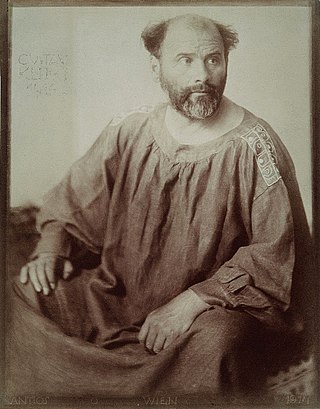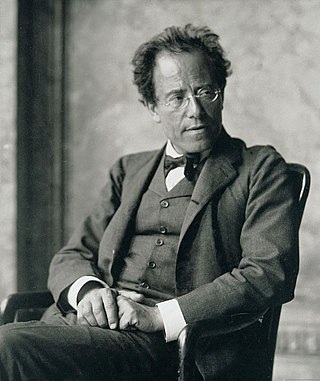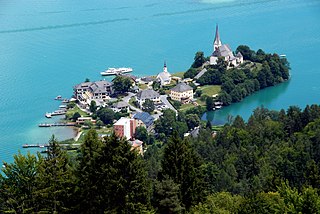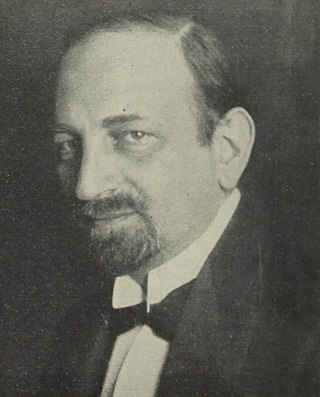
Gustav Klimt was an Austrian symbolist painter and one of the most prominent members of the Vienna Secession movement. Klimt is noted for his paintings, murals, sketches, and other objets d'art. Klimt's primary subject was the female body, and his works are marked by a frank eroticism. Amongst his figurative works, which include allegories and portraits, he painted landscapes. Among the artists of the Vienna Secession, Klimt was the most influenced by Japanese art and its methods.

Gustav Mahler was an Austro-Bohemian Romantic composer, and one of the leading conductors of his generation. As a composer he acted as a bridge between the 19th-century Austro-German tradition and the modernism of the early 20th century. While in his lifetime his status as a conductor was established beyond question, his own music gained wide popularity only after periods of relative neglect, which included a ban on its performance in much of Europe during the Nazi era. After 1945 his compositions were rediscovered by a new generation of listeners; Mahler then became one of the most frequently performed and recorded of all composers, a position he has sustained into the 21st century.

Bruno Walter was a German-born conductor, pianist and composer. Born in Berlin, he escaped Nazi Germany in 1933, was naturalised as a French citizen in 1938, and settled in the United States in 1939. He worked closely with Gustav Mahler, whose music he helped to establish in the repertory, held major positions with the Leipzig Gewandhaus Orchestra, New York Philharmonic, Concertgebouw Orchestra, Salzburg Festival, Vienna State Opera, Bavarian State Opera, Staatsoper Unter den Linden and Deutsche Oper Berlin, among others, made recordings of historical and artistic significance, and is widely considered to be one of the great conductors of the 20th century.

The Symphony No. 8 in E-flat major by Gustav Mahler is one of the largest-scale choral works in the classical concert repertoire. As it requires huge instrumental and vocal forces it is frequently called the "Symphony of a Thousand", although the work is normally presented with far fewer than a thousand performers and the composer did not sanction that name – actually, he disapproved of it. The work was composed in a single inspired burst at his Maiernigg villa in southern Austria in the summer of 1906. The last of Mahler's works that was premiered in his lifetime, the symphony was a critical and popular success when he conducted the Munich Philharmonic in its first performance, in Munich, on 12 September 1910.

The Symphony No. 3 in D minor by Gustav Mahler was written in sketch beginning in 1893, composed primarily in 1895, and took final form in 1896. Consisting of six movements, it is Mahler's longest composition and is the longest symphony in the standard repertoire, with a typical performance lasting around 95 to 110 minutes. It was voted one of the ten greatest symphonies of all time in a survey of conductors carried out by the BBC Music Magazine.

Alma Mahler-Werfel was an Austrian composer, author, editor, and socialite. Musically active from her early years, she was the composer of nearly fifty songs for voice and piano, and works in other genres as well. 17 songs are known to have survived. At 15, she was mentored by Max Burckhard.

The Rückert-Lieder is a collection of five Lieder for voice and orchestra or piano by Gustav Mahler, based on poems written by Friedrich Rückert. Four of the songs were written in the summer of 1901 at Maiernigg, with one completed in the summer of 1902, also in Maiernigg. Both smaller in orchestration and briefer than Mahler's previous Der Knaben Wunderhorn settings, the collection marked a change of style from the childlike, often satirical Wunderhorn settings, to a more lyrical, contrapuntal style. The collection is often linked with the Kindertotenlieder, Mahler's other settings of Rückert's poetry, and with the 5th Symphony, and both were composed concurrently with the collection and contain subtle references to the Rückert-Lieder.
The music of Trentino-Alto Adige/Südtirol reflects the multilingual and multiethnic make-up of the region. The strong traditions of choral singing, village bands, and folk music are nurtured both by the Italian and German speakers of the area.

Toblach is a comune/Gemeinde (municipality) in South Tyrol in Northern Italy, located in the Puster Valley about 70 kilometres (43 mi) northeast of the city of Bolzano, on the border with Austria.

Steinbach am Attersee is a municipality of the Vöcklabruck district in the Austrian state of Upper Austria. It is situated in the Hausruckviertel region on the eastern banks of the Attersee, part of the Salzkammergut area.

The Tre Cime di Lavaredo, also called the Drei Zinnen ; pronounced[ˌdʁaɪˈtsɪnən] ), are three distinctive battlement-like peaks, in the Sexten Dolomites of northeastern Italy. They are probably one of the best-known mountain groups in the Alps. The three peaks, from east to west, are:

Maria Wörth is a municipality in the district of Klagenfurt-Land in the Austrian state of Carinthia. The centre of the resort town is situated on a peninsula at the southern shore of the Wörthersee. In the east, the municipal area borders the Carinthian capital Klagenfurt. The municipality consists of the two Katastralgemeinden Maria Wörth and Reifnitz.

Pörtschach am Wörthersee is a municipality in the district of Klagenfurt-Land in Carinthia, Austria. It is an established summer resort and lakeside town on Wörthersee.

Josef Hoffmann was an Austrian-Moravian architect and designer. He was among the founders of Vienna Secession and co-establisher of the Wiener Werkstätte. His most famous architectural work is the Stoclet Palace, in Brussels, (1905–1911) a pioneering work of Modern Architecture, Art Deco and peak of Vienna Secession architecture.

Grete Wiesenthal was an Austrian dancer, actor, choreographer, and dance teacher. She transformed the Viennese Waltz from a staple of the ballroom into a wildly ecstatic dance. She was trained at the Vienna Court Opera, but left to develop her own more expressive approach, creating ballets to music by Franz Schreker, Clemens von Franckenstein, and Franz Salmhofer, as well as dancing in her own style to the waltzes of Johann Strauss II. She is considered a leading figure in modern dance in Austria.
Franz Mittler was an Austrian composer, musician, and humorist.

Paul Stefan, born Paul Stefan Grünfeld was an Austrian music historian and critic.

The composing hut of Gustav Mahler, German: Gustav Mahler-Komponierhäuschen, is a little museum and memorial in Steinbach at lake Attersee in Upper Austria. It is dedicated to the classical composer Gustav Mahler (1860–1911). In this hut he retreated from 1893 to 1896 in order to compose music. Since 1985 a permanent exhibition can be seen here.
Composing hut of Gustav Mahler may refer to

The composing hut of Gustav Mahler is a small museum and memorial in Maiernigg, near Maria Wörth in Carinthia, Austria. It is dedicated to the classical composer Gustav Mahler (1860–1911). He retreated into this hut from 1900 to 1907 to compose music. Since 7 July 1986, a permanent exhibition has been established here.



















